[TOC]
说明: 下列文章主要对尚硅谷《SpringBoot视频教程》的总结,下列文字描述来源他们的课件。
视频地址: https://www.bilibili.com/video/av38657363/?p=9
spingboot版本2.1.5.RELEASE
静态资源的映射规则
webjars
所有 /webjars/** ,都去 classpath:/META-INF/resources/webjars/ 找资源,webjars:以jar包的方式引入静态资源;
http://www.webjars.org/ 这里有很多前端的框架maven库。
jquery.js包导入
<!--引入jquery-webjar-->在访问的时候只需要写webjars下面资源的名称即可
<dependency>
<groupId>org.webjars</groupId>
<artifactId>jquery</artifactId>
<version>3.3.1</version>
</dependency>
localhost:8080/webjars/jquery/3.3.1/jquery.js
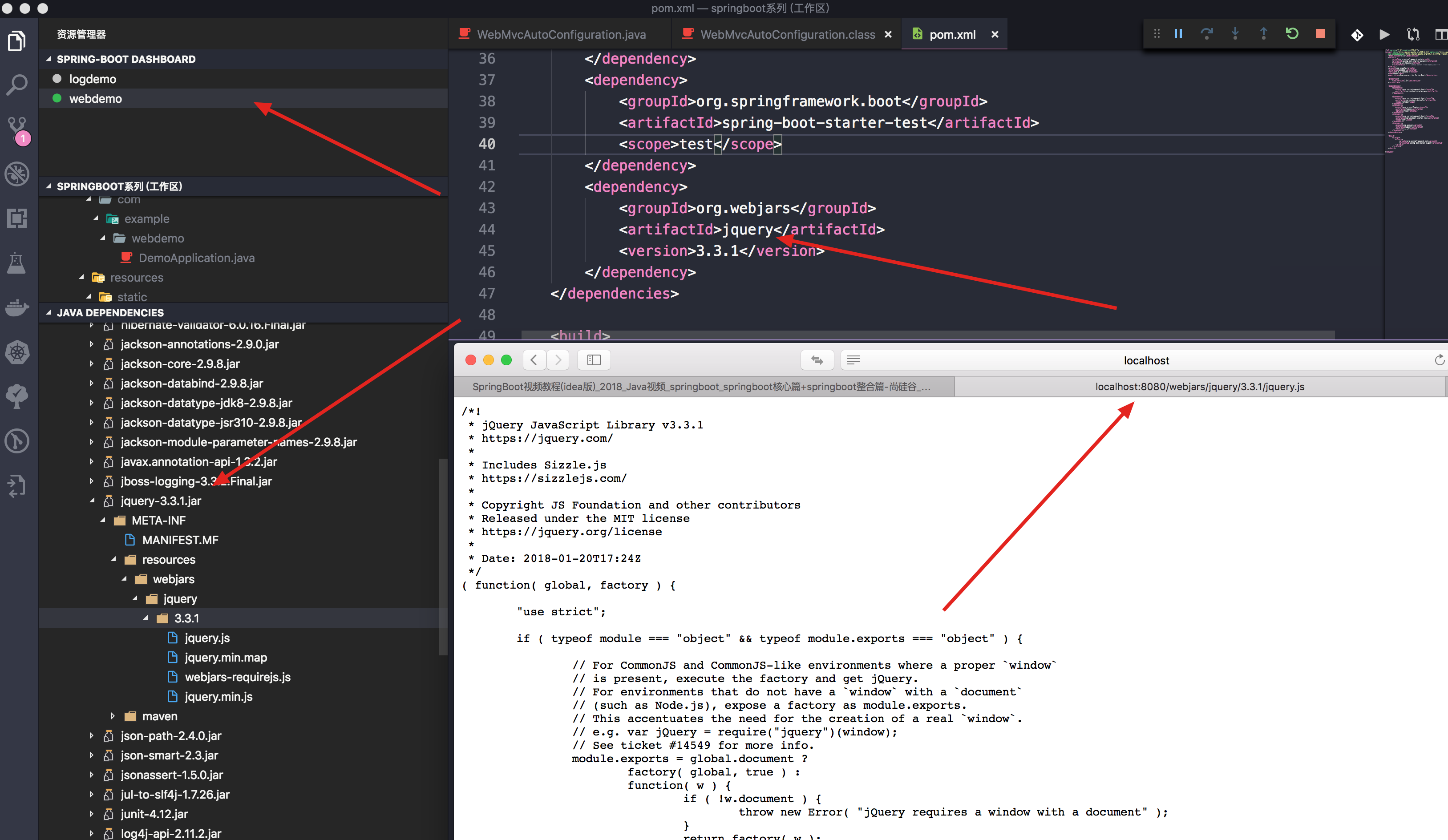
默认静态资源的文件夹
"classpath:/META-INF/resources/",
"classpath:/resources/",
"classpath:/static/",
"classpath:/public/"
"/":当前项目的根路径
http://localhost:8080/temp.jpg 就直接到这些文件夹下面去找。
欢迎页面
欢迎页; 静态资源文件夹下的所有index.html页面;被"/**“映射;
localhost:8080/ 找index页面
favicon.ico图标
所有的 **/favicon.ico 都是在静态资源文件下找;
源码分析
spring-boot-autoconfigure.jar中package org.springframework.boot.autoconfigure.web.servlet;这个WebMvcAutoConfiguration类处理。
@Override
public void addResourceHandlers(ResourceHandlerRegistry registry) {
if (!this.resourceProperties.isAddMappings()) {
logger.debug("Default resource handling disabled");
return;
}
Integer cachePeriod = this.resourceProperties.getCachePeriod();
if (!registry.hasMappingForPattern("/webjars/**")) {
customizeResourceHandlerRegistration(
registry.addResourceHandler("/webjars/**")
.addResourceLocations(
"classpath:/META-INF/resources/webjars/")
.setCachePeriod(cachePeriod));
}
String staticPathPattern = this.mvcProperties.getStaticPathPattern();
//静态资源文件夹映射
if (!registry.hasMappingForPattern(staticPathPattern)) {
customizeResourceHandlerRegistration(
registry.addResourceHandler(staticPathPattern)
.addResourceLocations(
//默认的静态文件夹,如下代码块-2
this.resourceProperties.getStaticLocations())
.setCachePeriod(cachePeriod));
}
}
//配置欢迎页映射
@Bean
public WelcomePageHandlerMapping welcomePageHandlerMapping(
ResourceProperties resourceProperties) {
return new WelcomePageHandlerMapping(resourceProperties.getWelcomePage(),
this.mvcProperties.getStaticPathPattern());
}
//配置喜欢的图标
@Configuration
@ConditionalOnProperty(value = "spring.mvc.favicon.enabled", matchIfMissing = true)
public static class FaviconConfiguration {
private final ResourceProperties resourceProperties;
public FaviconConfiguration(ResourceProperties resourceProperties) {
this.resourceProperties = resourceProperties;
}
@Bean
public SimpleUrlHandlerMapping faviconHandlerMapping() {
SimpleUrlHandlerMapping mapping = new SimpleUrlHandlerMapping();
mapping.setOrder(Ordered.HIGHEST_PRECEDENCE + 1);
//所有 **/favicon.ico
mapping.setUrlMap(Collections.singletonMap("**/favicon.ico",
faviconRequestHandler()));
return mapping;
}
}
代码块-2
@ConfigurationProperties(prefix = "spring.resources", ignoreUnknownFields = false)
public class ResourceProperties {
private static final String[] CLASSPATH_RESOURCE_LOCATIONS = {
"classpath:/META-INF/resources/", "classpath:/resources/",
"classpath:/static/", "classpath:/public/" };
修改路径
#如果修改了,原来的默认设置都不行了, 一般不修改。
spring.resources.static-locations*=classpath:/hello/
thymeleaf模板引擎
默认配置
spring-boot-autoconfigure.jar中package org.springframework.boot.autoconfigure.thymeleaf;
@ConfigurationProperties(prefix = "spring.thymeleaf")
public class ThymeleafProperties {
private static final Charset DEFAULT_ENCODING = StandardCharsets.UTF_8;
public static final String DEFAULT_PREFIX = "classpath:/templates/";
public static final String DEFAULT_SUFFIX = ".html";
只要我们把HTML页面放在classpath:/templates/,thymeleaf就能自动渲染;
简单使用
@Controller
public class DemoController {
@Autowired
private HttpServletRequest request;
@RequestMapping("/success")
public String success() {
request.setAttribute("hello", "你好");
request.setAttribute("hello2", "<h1>你好</h1>");
request.setAttribute("userData", Arrays.asList("李四","王五","张三"));
return "success";
}
}
<!DOCTYPE html>
<html lang="en" xmlns:th="http://www.thymeleaf.org">
<head>
<meta charset="UTF-8">
<title>Title</title>
</head>
<body>
<h1>成功!</h1>
<!--th:text 将div里面的文本内容设置为 转义-->
<div th:text="${hello2}">这是显示欢迎信息</div>
<!--th:utext 不转义-->
<div th:utext="${hello2}"></div>
<hr />
<!--th:each 循环一个一个输出-->
<h1 th:text="${user}" th:each="user:${userData}"></h1>
<hr />
<!--th:each 循环一次输出-->
<h1>
<span th:each="user:${userData}">[[${user}]],</span>
</h1>
</body>
</html>
xmlns:th=“http://www.thymeleaf.org” 这个用于写的时候,标签有提示。
注意: 用这个模板感觉好处是,如果前端做了一个页面出来了, 我们可以不加入thymeleaf的标签的话,那么他就是显示原网页,加入后,直接替换里面的文字改为动态化。这个用于前端和后端的分离是很好的。
扩展SpringMVC
编写一个配置类(@Configuration),是WebMvcConfigurerAdapter类型;不能标注@EnableWebMvc
既保留了所有的自动配置,也能用我们扩展的配置;
//使用WebMvcConfigurerAdapter可以来扩展SpringMVC的功能
@Configuration
public class MyMvcConfig extends WebMvcConfigurerAdapter {
@Override
public void addViewControllers(ViewControllerRegistry registry) {
// super.addViewControllers(registry);
//浏览器发送 /atguigu 请求来到 success
registry.addViewController("/atguigu").setViewName("success");
}
//所有的WebMvcConfigurerAdapter组件都会一起起作用
@Bean //将组件注册在容器
public WebMvcConfigurerAdapter webMvcConfigurerAdapter(){
WebMvcConfigurerAdapter adapter = new WebMvcConfigurerAdapter() {
@Override
public void addViewControllers(ViewControllerRegistry registry) {
registry.addViewController("/").setViewName("login");
registry.addViewController("/index.html").setViewName("login");
}
//注册拦截器
@Override
public void addInterceptors(InterceptorRegistry registry) {
//super.addInterceptors(registry);
//静态资源; *.css , *.js
//SpringBoot已经做好了静态资源映射
registry.addInterceptor(new LoginHandlerInterceptor()).addPathPatterns("/**")
.excludePathPatterns("/index.html","/","/user/login");
}
};
return adapter;
}
}
WebMvcConfigurerAdapter 这个接口里面有很多可以重写的抽象方法。上面的就可以定义以这个/atguigu请求的都到转到success的页面中。
多请求映射
@RequestMapping({"/success","/"})
public String success() {
request.setAttribute("hello", "你好");
request.setAttribute("hello2", "<h1>你好</h1>");
request.setAttribute("userData", Arrays.asList("李四","王五","张三"));
return "success";
}
引入资源

国际化
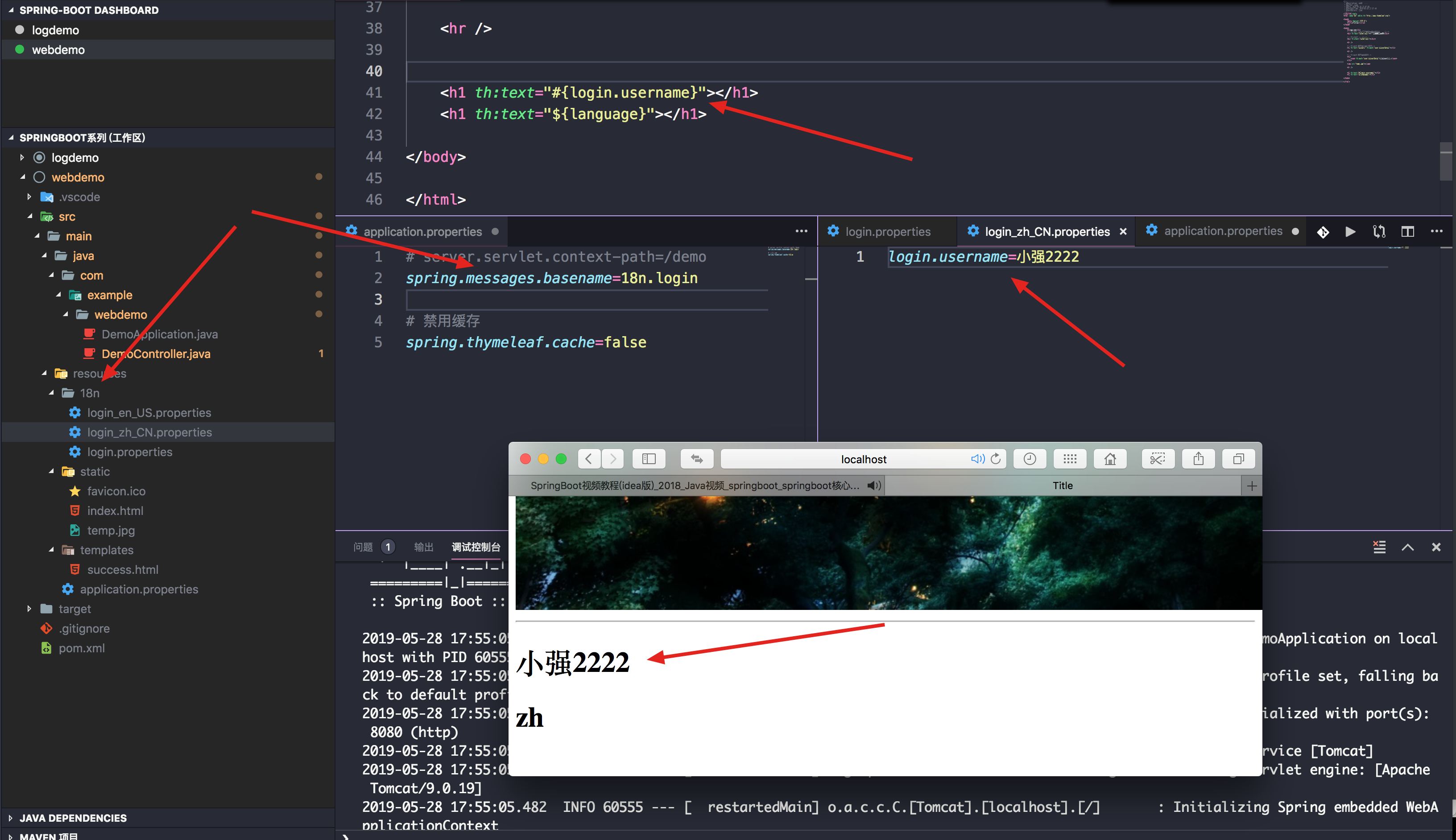
自定义拦截器
* 登陆检查,
*/
public class LoginHandlerInterceptor implements HandlerInterceptor {
//目标方法执行之前
@Override
public boolean preHandle(HttpServletRequest request, HttpServletResponse response, Object handler) throws Exception {
Object user = request.getSession().getAttribute("loginUser");
if(user == null){
//未登陆,返回登陆页面
request.setAttribute("msg","没有权限请先登陆");
request.getRequestDispatcher("/index.html").forward(request,response);
return false;
}else{
//已登陆,放行请求
return true;
}
}
@Override
public void postHandle(HttpServletRequest request, HttpServletResponse response, Object handler, ModelAndView modelAndView) throws Exception {
}
@Override
public void afterCompletion(HttpServletRequest request, HttpServletResponse response, Object handler, Exception ex) throws Exception {
}
}
RestFul风格
使用Rest前,首先说一说Rest请求方式的好处,首先就是面向资源URI,即http请求的路径,Rest规定中要求URI各层只能用名词不用动词,这样相比传统的get请求有利于传输数据的稳定性,数据的操作流程不会被人轻易看破,也便于团队开发,各种URI一目了然;再通过固定的请求方式,对URI中的资源进行各种操作,常用的有:
URI: /资源名称/资源标识 HTTP请求方式区分对资源CRUD操作
| 普通CRUD(uri来区分操作) | RestfulCRUD | |
|---|---|---|
| 查询 | getEmp | emp—GET @GetMapping(value=“path”) |
| 添加 | addEmp?xxx | emp—POST @PostMapping(value=“path”) |
| 修改 | updateEmp?id=xxx&xxx=xx | emp/{id}—PUT @PutMapping(value=“path/{id}") |
| 删除 | deleteEmp?id=1 | emp/{id}—DELETE @DeleteMapping |
前端需要PUT,DELETE提交的时候, 设置nginx的配置文件就好了。
定制错误的页面
有模板引擎的情况下
【将错误页面命名为 错误状态码.html 放在模板引擎文件夹里面的 error文件夹下】,发生此状态码的错误就会来到 对应的页面;我们可以使用4xx和5xx作为错误页面的文件名来匹配这种类型的所有错误,精确优先(优先寻找精确的状态码.html);
#页面能获取的信息;
timestamp:时间戳
status:状态码
error:错误提示
exception:异常对象
message:异常消息
errors:JSR303数据校验的错误都在这里
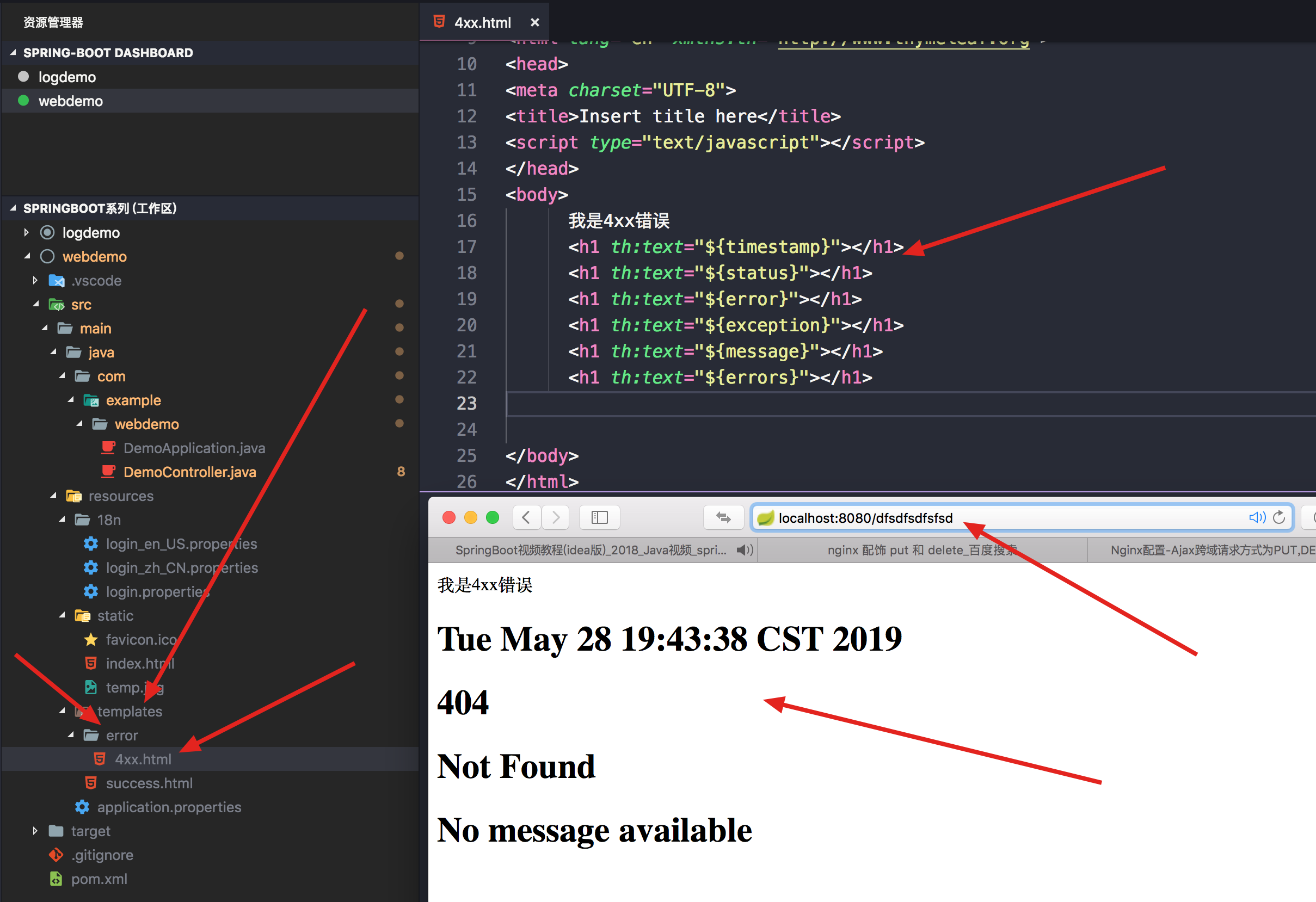
没有模板引擎
模板引擎(也就是templates文件夹)找不到这个错误页面,静态资源文件夹下找;
异常统一处理
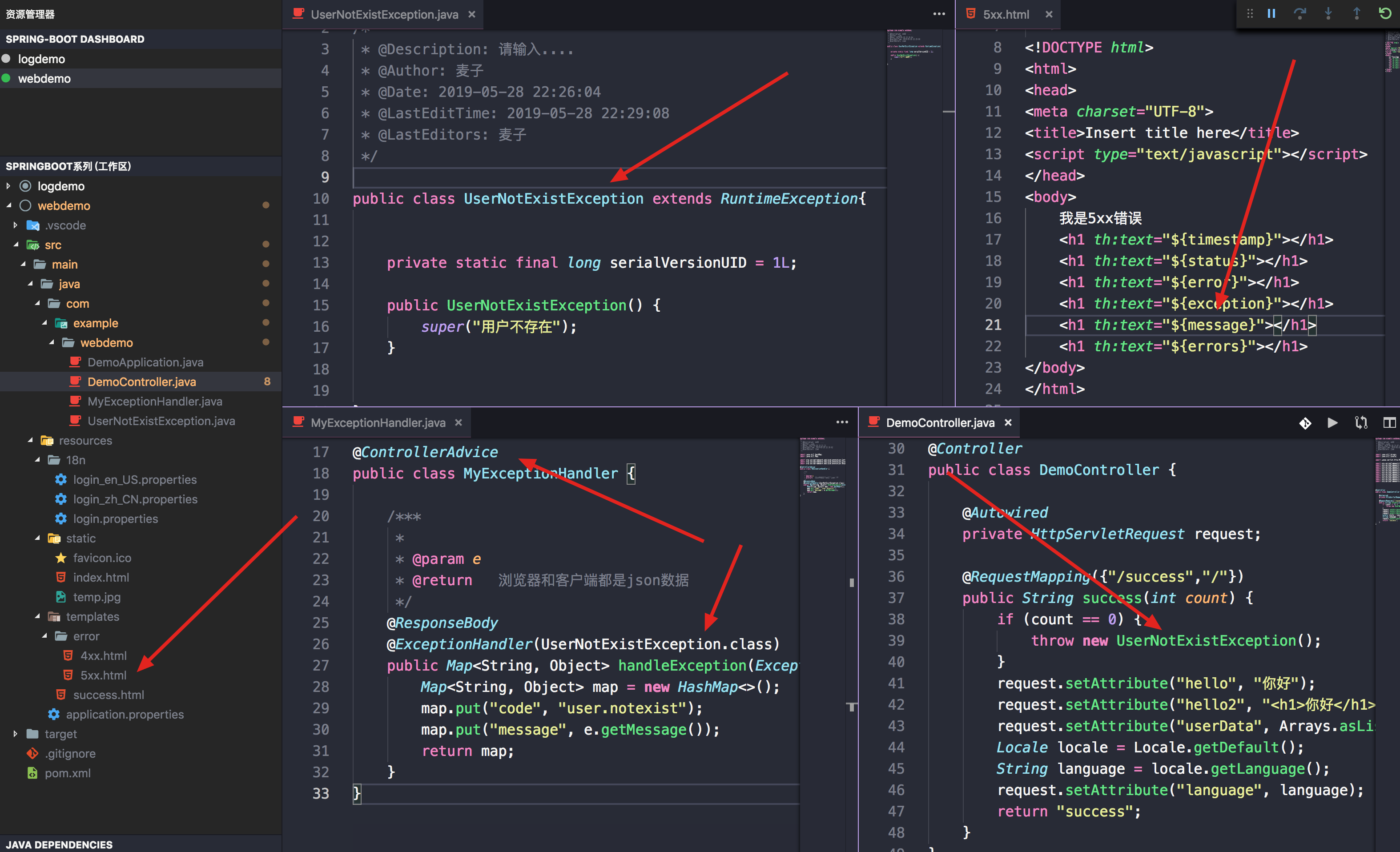
效果如下:
{
"code":"user.notexist",
"message":"用户不存在"
}
处理自定义异常代码
@ControllerAdvice
public class MyExceptionHandler {
/***
*
* @param e
* @return 浏览器和客户端都是json数据
*/
@ResponseBody
@ExceptionHandler(UserNotExistException.class)
public Map<String, Object> handleException(Exception e) {
Map<String, Object> map = new HashMap<>();
map.put("code", "user.notexist");
map.put("message", e.getMessage());
return map;
}
}
自动适应web和客户端异常代码
/**
*
* @param e
* @param request
* @return 自动适应 web端和客户端端处理,也就是web端显示的错误信息和客户端返回的错误信息不一样
*/
@ExceptionHandler(UserNotExistException.class)
public String handleException(Exception e, HttpServletRequest request){
Map<String,Object> map = new HashMap<>();
//传入我们自己的错误状态码 4xx 5xx,否则就不会进入定制错误页面的解析流程
/**
* Integer statusCode = (Integer) request
.getAttribute("javax.servlet.error.status_code");
*/
request.setAttribute("javax.servlet.error.status_code",500);
map.put("code","user.notexist");
map.put("message",e.getMessage());
request.setAttribute("resultData", map);
//转发到/error
return "forward:/error";
}
出现错误以后,会来到/error请求,会被BasicErrorController处理,响应出去可以获取的数据是由getErrorAttributes得到的。
import org.springframework.boot.web.servlet.error.DefaultErrorAttributes;
import org.springframework.stereotype.Component;
import org.springframework.web.context.request.RequestAttributes;
import org.springframework.web.context.request.WebRequest;
//给容器中加入我们自己定义的ErrorAttributes
@Component
public class MyErrorAttributes extends DefaultErrorAttributes {
@Override
public Map<String, Object> getErrorAttributes(WebRequest requestAttributes, boolean includeStackTrace) {
Map<String, Object> map = super.getErrorAttributes(requestAttributes, includeStackTrace);
map.put("company","atguigu");
Map<String,Object> data = (Map<String, Object>) requestAttributes.getAttribute("resultData",
RequestAttributes.SCOPE_REQUEST);
map.put("result", data);
return map;
}
}
显示效果如下:
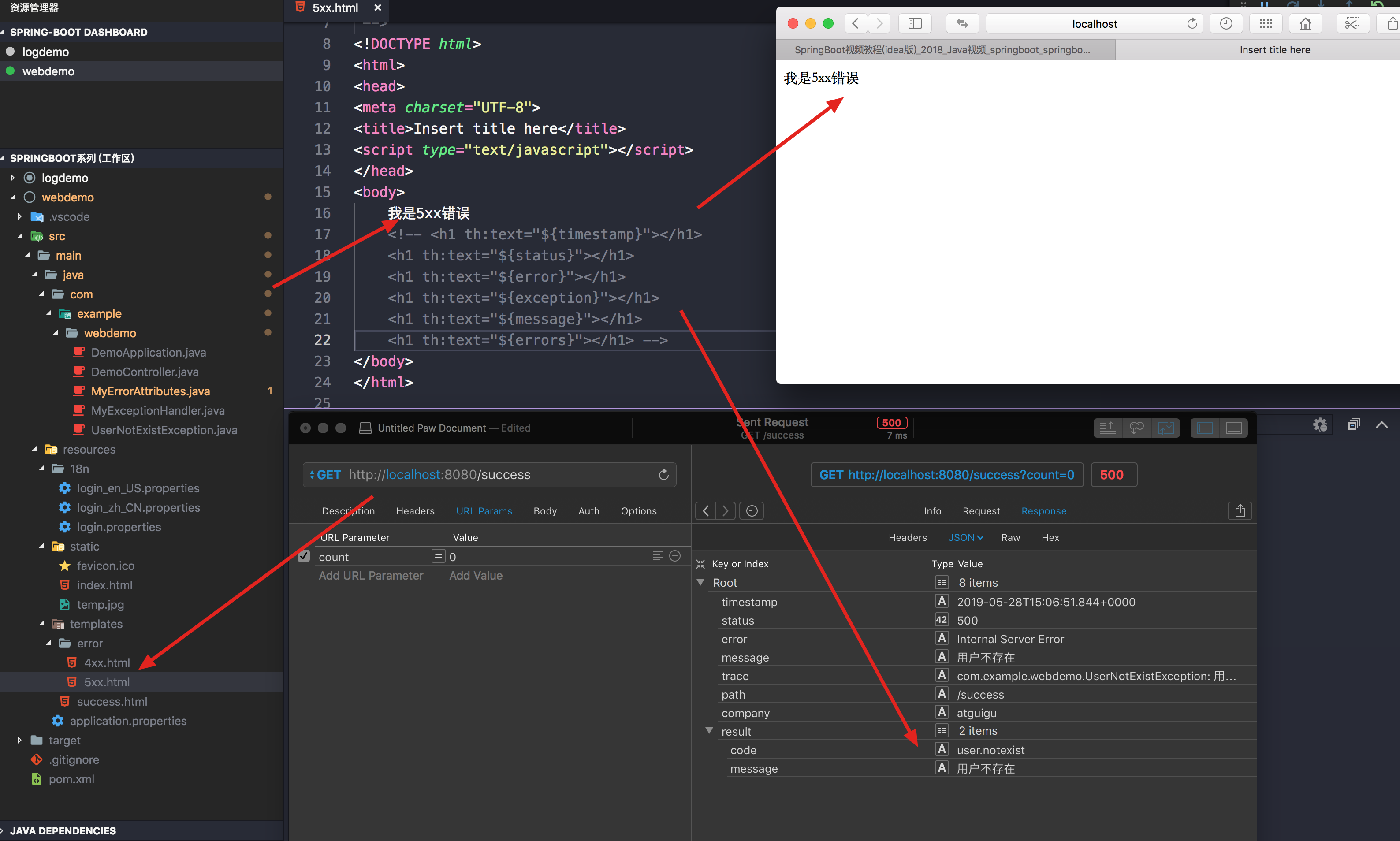
注意:在我们开发中, 500错误可以自定义一个页面给用户看,客户端的调用接口时候就给他看错误json日志。
配置嵌入式Servlet容器
tomcat就是一个servlet容器。springboot也就是默认用这个。
server.port=8081
server.context-path=/crud
server.tomcat.uri-encoding=UTF-8
#通用的Servlet容器设置
server.xxx
#Tomcat的设置
server.tomcat.xxx
注册Servlet三大组件
Servlet
public class MyServlet extends HttpServlet{
private static final long serialVersionUID = 1L;
@Override
protected void doGet(HttpServletRequest req, HttpServletResponse resp) throws ServletException, IOException {
doPost(req, resp);
}
@Override
protected void doPost(HttpServletRequest req, HttpServletResponse resp) throws ServletException, IOException {
resp.getWriter().write("hello,my servlet");
}
}
Filter
public class MyFifter implements Filter {
@Override
public void init(FilterConfig filterConfig) throws ServletException {
Filter.super.init(filterConfig);
}
@Override
public void doFilter(ServletRequest request, ServletResponse response, FilterChain chain)
throws IOException, ServletException {
System.out.println("filter execute...");
chain.doFilter(request, response);
}
@Override
public void destroy() {
Filter.super.destroy();
}
}
Listener
public class MyListener implements ServletContextListener{
@Override
public void contextInitialized(ServletContextEvent sce) {
System.out.println("tomcat 已经启动");
}
@Override
public void contextDestroyed(ServletContextEvent sce) {
System.out.println("tomcat 已经停止");
}
}
注入到容器中
@Configuration
public class MyServiceConfig {
@Bean
public ServletRegistrationBean myServlet() {
ServletRegistrationBean registrationBean = new ServletRegistrationBean(new MyServlet(), "/myServlet");
return registrationBean;
}
@Bean
public FilterRegistrationBean myFilter() {
FilterRegistrationBean registrationBean = new FilterRegistrationBean();
registrationBean.setFilter(new MyFifter());
registrationBean.setUrlPatterns(Arrays.asList("/hello", "/myServlet"));
return registrationBean;
}
@Bean
public ServletListenerRegistrationBean myListener() {
ServletListenerRegistrationBean<MyListener> registrationBean = new ServletListenerRegistrationBean<>(
new MyListener());
return registrationBean;
}
}
注意:需要一些详细的属性设置,在这里也可以进行设置处理。
替换为其他嵌入式Servlet容器
Tomcat(默认使用)
<dependency>
<groupId>org.springframework.boot</groupId>
<artifactId>spring-boot-starter-web</artifactId>
引入web模块默认就是使用嵌入式的Tomcat作为Servlet容器;
</dependency>
Jetty
<!-- 引入web模块 -->
<dependency>
<groupId>org.springframework.boot</groupId>
<artifactId>spring-boot-starter-web</artifactId>
<exclusions>
<exclusion>
<artifactId>spring-boot-starter-tomcat</artifactId>
<groupId>org.springframework.boot</groupId>
</exclusion>
</exclusions>
</dependency>
<!--引入其他的Servlet容器-->
<dependency>
<artifactId>spring-boot-starter-jetty</artifactId>
<groupId>org.springframework.boot</groupId>
</dependency>
使用外置的Servlet容器
嵌入式Servlet容器:应用打成可执行的jar
优点:简单、便携;
缺点:默认不支持JSP、优化定制比较复杂。
外置的Servlet容器
外面安装Tomcat—应用war包的方式打包;
1)、必须创建一个war项目;(利用idea创建好目录结构)
2)、将嵌入式的Tomcat指定为provided;
<dependency>
<groupId>org.springframework.boot</groupId>
<artifactId>spring-boot-starter-tomcat</artifactId>
<scope>provided</scope>
</dependency>
3)、必须编写一个SpringBootServletInitializer的子类,并调用configure方法
public class ServletInitializer extends SpringBootServletInitializer {
@Override
protected SpringApplicationBuilder configure(SpringApplicationBuilder application) {
//传入SpringBoot应用的主程序
return application.sources(SpringBoot04WebJspApplication.class);
}
}
4)、启动服务器就可以使用;
原理
jar包:执行SpringBoot主类的main方法,启动ioc容器,创建嵌入式的Servlet容器;
war包:启动服务器,服务器启动SpringBoot应用【SpringBootServletInitializer】,启动ioc容器;
自定义Spring Boot的父POM
<parent>
<artifactId>mycloud</artifactId>
<groupId>maizi.cloud</groupId>
<version>1.0-SNAPSHOT</version>
</parent>
<modelVersion>4.0.0</modelVersion>
<artifactId>consumer-9001</artifactId>
<dependencyManagement>
<dependencies>
<dependency>
<!-- Import dependency management from Spring Boot -->
<groupId>org.springframework.boot</groupId>
<artifactId>spring-boot-dependencies</artifactId>
<version>2.1.4.RELEASE</version>
<type>pom</type>
<scope>import</scope>
</dependency>
</dependencies>
</dependencyManagement>
「真诚赞赏,手留余香」
真诚赞赏,手留余香
使用微信扫描二维码完成支付
